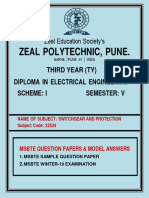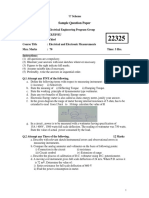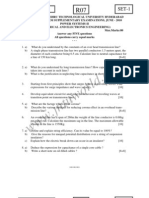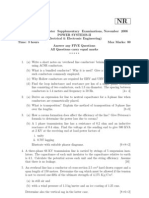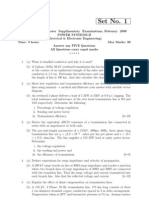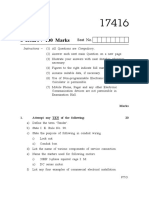Professional Documents
Culture Documents
Shri Sai Taj Polytechnic, Nagpur: Session: 2015-2016 First Class Test
Shri Sai Taj Polytechnic, Nagpur: Session: 2015-2016 First Class Test
Uploaded by
sahil satpute0 ratings0% found this document useful (0 votes)
17 views1 pageThe document is a test paper for the subject "Transmission & Distribution of Electrical power" from Shri Sai Taj Polytechnic, Nagpur. It contains 3 questions with multiple parts assessing student knowledge of topics like the classification of transmission lines, types of conductors used, standard voltages in India, parts of underground cables, properties of insulating materials, and comparisons of overhead and underground lines. Calculations related to line voltages and string efficiencies are also tested. The test has a total of 25 marks and is to be completed within 1 hour.
Original Description:
tde
Original Title
tde
Copyright
© © All Rights Reserved
Available Formats
DOCX, PDF, TXT or read online from Scribd
Share this document
Did you find this document useful?
Is this content inappropriate?
Report this DocumentThe document is a test paper for the subject "Transmission & Distribution of Electrical power" from Shri Sai Taj Polytechnic, Nagpur. It contains 3 questions with multiple parts assessing student knowledge of topics like the classification of transmission lines, types of conductors used, standard voltages in India, parts of underground cables, properties of insulating materials, and comparisons of overhead and underground lines. Calculations related to line voltages and string efficiencies are also tested. The test has a total of 25 marks and is to be completed within 1 hour.
Copyright:
© All Rights Reserved
Available Formats
Download as DOCX, PDF, TXT or read online from Scribd
Download as docx, pdf, or txt
0 ratings0% found this document useful (0 votes)
17 views1 pageShri Sai Taj Polytechnic, Nagpur: Session: 2015-2016 First Class Test
Shri Sai Taj Polytechnic, Nagpur: Session: 2015-2016 First Class Test
Uploaded by
sahil satputeThe document is a test paper for the subject "Transmission & Distribution of Electrical power" from Shri Sai Taj Polytechnic, Nagpur. It contains 3 questions with multiple parts assessing student knowledge of topics like the classification of transmission lines, types of conductors used, standard voltages in India, parts of underground cables, properties of insulating materials, and comparisons of overhead and underground lines. Calculations related to line voltages and string efficiencies are also tested. The test has a total of 25 marks and is to be completed within 1 hour.
Copyright:
© All Rights Reserved
Available Formats
Download as DOCX, PDF, TXT or read online from Scribd
Download as docx, pdf, or txt
You are on page 1of 1
SHRI SAI TAJ POLYTECHNIC, NAGPUR
Session: 2015-2016
First Class Test
Course Name: Electrical Engineering 17417
Course Code: EE
Semester : FOURTH
Subject : Transmission & Distribution of Electrical power (TDE)
Marks : 25 Time: 1Hr
Instructions:
1) All questions are compulsory.
2) Illustrates your answer with neat sketches wherever necessary.
3) Figure to right indicate full marks.
4) Assume suitable data if necessary.
5) Preferably, write the answers in sequential order.
Q.1 Attempt Any Three. (9Marks)
a) How are the transmission lines classified as per the distance?
b) State the different types of conductors used in transmission system.
c) State the standard voltages in India — Transmission line and Distribution
line.
d) Draw diagram of underground cable showing all the parts..
e) State the classification of cables based on voltage levels.
Q.2 Attempt Any Two. (8Marks)
a) List four advantages of using high voltage for transmission lines.
b) State the electrical and mechanical properties of insulating materials.
c) Compare overhead and underground lines on basis of flexibility,
maintenance, safety and cost.
Q.3 Attempt Any Two. (8Marks)
a) Explain the procedure of cable laying.
b) Suggest with reasons the type of insulators used for following voltage levels
of transmission and distribution system.(i)11 KV Distributors (ii) 132 KV
Feeder (iii) 400 KV Tower (iv) 33 KV Distributor
c) A 3 - ph overhead line is being supported by three disc insulators. The potential
across line unit is 17.5 KV. Assume that shunt capacitance between each
insulator and each metal work of tower to be 1/10th of capacitance of insulator.
Calculate (i) Line voltage (ii) String efficiency
You might also like
- 17417-Transmission and Distribution of Electrical PowerDocument10 pages17417-Transmission and Distribution of Electrical PowerRajinder BarwalNo ratings yet
- Zeal Polytechnic, Pune.: Third Year (Ty) Diploma in Electrical Engineering Scheme: I Semester: VDocument23 pagesZeal Polytechnic, Pune.: Third Year (Ty) Diploma in Electrical Engineering Scheme: I Semester: Vmrdevendra0710No ratings yet
- Sample Question Paper Electrical Materials and Wiring PracticeDocument5 pagesSample Question Paper Electrical Materials and Wiring Practicenitinsurwadkar042No ratings yet
- 22633-Sample-Question-Paper (Msbte Study Resources)Document4 pages22633-Sample-Question-Paper (Msbte Study Resources)vilas kumar100% (6)
- IES-1-17416 First Class Test PAPER 1Document2 pagesIES-1-17416 First Class Test PAPER 1sahil satputeNo ratings yet
- Laqshya Institute of Technology & Sciences: Part-ADocument1 pageLaqshya Institute of Technology & Sciences: Part-Asamson4314No ratings yet
- Switchgear and ProtectionDocument4 pagesSwitchgear and ProtectionRavindraNo ratings yet
- Sample Question Paper Basic Electrical & Electronics EngineeringDocument4 pagesSample Question Paper Basic Electrical & Electronics Engineeringsachin tupeNo ratings yet
- 22625-Sample-Question-Paper (Msbte Study Resources)Document4 pages22625-Sample-Question-Paper (Msbte Study Resources)vilas kumar100% (2)
- 22626-Sample UEE QuestionsDocument4 pages22626-Sample UEE QuestionsVishesh RautNo ratings yet
- Wa19Document14 pagesWa19michaelchimuanya659No ratings yet
- 6635-Sept-Oct-2020Document6 pages6635-Sept-Oct-2020Zing ZuuNo ratings yet
- WWW - Manaresults.Co - In: Power Systems - Ii (T, D & P)Document2 pagesWWW - Manaresults.Co - In: Power Systems - Ii (T, D & P)tarunnvikramNo ratings yet
- Nr310203 Power Systems II Set1Document2 pagesNr310203 Power Systems II Set1Srinivasa Rao GNo ratings yet
- Microwave EngineeringDocument4 pagesMicrowave EngineeringAbhishekBarmaNo ratings yet
- Sample Question Paper Electrical and Electronic MeasurementDocument4 pagesSample Question Paper Electrical and Electronic MeasurementDeeo DhadiwalNo ratings yet
- Ece 514 1Document2 pagesEce 514 1Marlene EsipilaNo ratings yet
- Ece PaperDocument2 pagesEce Papersmohan_4uNo ratings yet
- Scheme - I Sample Question PaperDocument4 pagesScheme - I Sample Question Paperjijo123408No ratings yet
- Power Electronics Applications (Elective)Document4 pagesPower Electronics Applications (Elective)RavindraNo ratings yet
- Elements of Electrical Engineering Sample Question PaperDocument4 pagesElements of Electrical Engineering Sample Question PaperAjay BhondaveNo ratings yet
- All Questions Are Compulsory.: 31 August 2019Document5 pagesAll Questions Are Compulsory.: 31 August 2019SIDDHA YOGA MEDITATIONNo ratings yet
- ECA Exams Term 1Document2 pagesECA Exams Term 1Fred RotichNo ratings yet
- 07a50202 Power System IiDocument6 pages07a50202 Power System IiVenu AlgamNo ratings yet
- Sample Question Paper Principles of Electronics Communication 1Document6 pagesSample Question Paper Principles of Electronics Communication 1Akhlad Alqurash100% (1)
- MCQ EeeDocument9 pagesMCQ EeeVishal ThakurNo ratings yet
- 17417Document6 pages17417sahil satputeNo ratings yet
- nr310203 Power Systems II Set1Document2 pagesnr310203 Power Systems II Set1SRINIVASA RAO GANTANo ratings yet
- Model QuestionDocument2 pagesModel QuestionkrishnandrkNo ratings yet
- Important Questions of Power SystemDocument4 pagesImportant Questions of Power SystemShrutiNo ratings yet
- Gujarat Technological UniversityDocument1 pageGujarat Technological UniversityvagoliyoNo ratings yet
- Sample Question Paper (Msbte Study Resources)Document5 pagesSample Question Paper (Msbte Study Resources)Sneha LamdadeNo ratings yet
- 2014 Summer Model Answer PaperDocument38 pages2014 Summer Model Answer PaperromeoNo ratings yet
- Shri Sai Taj Polytechnic, Nagpur: Session: - 2015-2016 Assignment-1Document1 pageShri Sai Taj Polytechnic, Nagpur: Session: - 2015-2016 Assignment-1sahil satputeNo ratings yet
- 08 r05310203 Power Systems IIDocument8 pages08 r05310203 Power Systems IIandhracollegesNo ratings yet
- Google 11Document2 pagesGoogle 11Suraj TiwariNo ratings yet
- EE301 Power Generation, Transmission and Protection, December 2017 PDFDocument2 pagesEE301 Power Generation, Transmission and Protection, December 2017 PDFAfsal Abdul KarimNo ratings yet
- rr310203 Power Systems IIDocument8 pagesrr310203 Power Systems IISRINIVASA RAO GANTANo ratings yet
- .Trashed 1722265492 22419Document4 pages.Trashed 1722265492 22419gkulkarni298No ratings yet
- Power Electrical Past PaperDocument5 pagesPower Electrical Past PaperNadeesha BandaraNo ratings yet
- Sample PaperDocument4 pagesSample PaperHarsh MouryNo ratings yet
- Aei Trade Theory Exam T3 2024Document2 pagesAei Trade Theory Exam T3 2024phil2014No ratings yet
- Ee335-Transmission and Distribut PDFDocument2 pagesEe335-Transmission and Distribut PDFPradeep AmmasaikuttiNo ratings yet
- C14 Ee 404032016Document3 pagesC14 Ee 404032016Mahesh BiswalNo ratings yet
- Set No: 1 R10Document4 pagesSet No: 1 R10Viswa ChaitanyaNo ratings yet
- Https WWW - Suit.edu - PK Uploads Past Papers Power Transmission Distribution - ELC254Document1 pageHttps WWW - Suit.edu - PK Uploads Past Papers Power Transmission Distribution - ELC254GHS Kass Korona MardanNo ratings yet
- R05420203 HvdctransmissionDocument4 pagesR05420203 HvdctransmissionvanamgouthamNo ratings yet
- TD Question BankDocument7 pagesTD Question Bankcitian2008No ratings yet
- Question Paper Code:: (10 2 20 Marks)Document2 pagesQuestion Paper Code:: (10 2 20 Marks)Kaleeswari SaraswathiNo ratings yet
- PTEE7304 April-2014Document2 pagesPTEE7304 April-2014imman46920No ratings yet
- Power Transmission Distribution - EE2541Document2 pagesPower Transmission Distribution - EE2541info tim3No ratings yet
- School of Electronics EngineeringDocument1 pageSchool of Electronics EngineeringAndualemNo ratings yet
- Https WWW - Suit.edu - PK Uploads Past Papers Power Transmission Distribution - EE2541Document2 pagesHttps WWW - Suit.edu - PK Uploads Past Papers Power Transmission Distribution - EE2541GHS Kass Korona MardanNo ratings yet
- Revision SheetDocument7 pagesRevision SheetHarshwardhan PhatakNo ratings yet
- Oxford Public SR - Sec. School Nehtaur (Bijnor)Document2 pagesOxford Public SR - Sec. School Nehtaur (Bijnor)Harshit ChaudharyNo ratings yet
- MICROWAVE ECEDocument2 pagesMICROWAVE ECEABINASH SAMANTARAYNo ratings yet
- r05310203 Power Systems IIDocument8 pagesr05310203 Power Systems IISrinivasa Rao G100% (1)
- Bee - 2023 JulyDocument3 pagesBee - 2023 Julyeshanpadhiar3No ratings yet
- Impedance Spectroscopy: Theory, Experiment, and ApplicationsFrom EverandImpedance Spectroscopy: Theory, Experiment, and ApplicationsEvgenij BarsoukovNo ratings yet
- Distribution of Electrical Power: Lecture Notes of Distribution of Electric Power CourseFrom EverandDistribution of Electrical Power: Lecture Notes of Distribution of Electric Power CourseNo ratings yet
- Customer Registration of Arbro Pharmaceuticals Pvt. Ltd.Document2 pagesCustomer Registration of Arbro Pharmaceuticals Pvt. Ltd.sahil satputeNo ratings yet
- Advance Robotics & Embedded System: TrainingDocument9 pagesAdvance Robotics & Embedded System: Trainingsahil satputeNo ratings yet
- Microcontroller Based Data Acquisition System For Electrical Motor Vibrations Using VB SoftwareDocument11 pagesMicrocontroller Based Data Acquisition System For Electrical Motor Vibrations Using VB Softwaresahil satputeNo ratings yet
- Fault Detection of Induction Motor Using Current and Vibration MonitoringDocument8 pagesFault Detection of Induction Motor Using Current and Vibration Monitoringsahil satputeNo ratings yet
- Composition SET D1Document2 pagesComposition SET D1sahil satputeNo ratings yet
- Important Suggestions To ExaminersDocument30 pagesImportant Suggestions To Examinerssahil satputeNo ratings yet
- 3 Hours / 100 Marks: Seat NoDocument6 pages3 Hours / 100 Marks: Seat Nosahil satputeNo ratings yet
- 17417Document6 pages17417sahil satputeNo ratings yet
- Model 17415Document20 pagesModel 17415sahil satputeNo ratings yet
- Maharashtra State Boar Maharashtra State Board of Technical Education (Autonomous) (ISO/IEC-27001-2005 Certified) D of Technical EducationDocument26 pagesMaharashtra State Boar Maharashtra State Board of Technical Education (Autonomous) (ISO/IEC-27001-2005 Certified) D of Technical Educationsahil satputeNo ratings yet
- 3 Hours / 100 Marks: Seat NoDocument5 pages3 Hours / 100 Marks: Seat Nosahil satputeNo ratings yet
- Shri Sai Taj Polytechnic, Nagpur: Session: - 2015-2016 Assignment-1Document1 pageShri Sai Taj Polytechnic, Nagpur: Session: - 2015-2016 Assignment-1sahil satputeNo ratings yet
- 17415Document6 pages17415sahil satputeNo ratings yet
- 3 Hours / 100 Marks: Seat NoDocument4 pages3 Hours / 100 Marks: Seat Nosahil satputeNo ratings yet
- 3 Hours / 100 Marks: Seat NoDocument4 pages3 Hours / 100 Marks: Seat Nosahil satputeNo ratings yet
- 3 Hours / 100 Marks: Seat NoDocument6 pages3 Hours / 100 Marks: Seat Nosahil satputeNo ratings yet
- Summer 16Document6 pagesSummer 16sahil satputeNo ratings yet
- 3 Hours / 100 Marks: Seat NoDocument6 pages3 Hours / 100 Marks: Seat Nosahil satputeNo ratings yet
- Win 16Document4 pagesWin 16sahil satputeNo ratings yet

